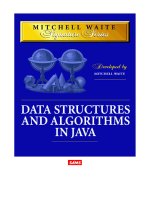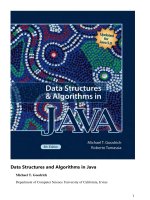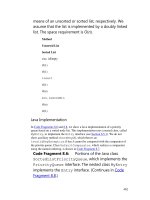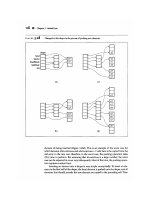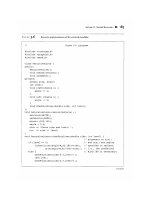Data Structures and Algorithms in Java 4th phần 4 ppsx
Bạn đang xem bản rút gọn của tài liệu. Xem và tải ngay bản đầy đủ của tài liệu tại đây (1.66 MB, 92 trang )
and then fill the array back up again by popping the elements off of the stack. In
Code Fragment 5.8, we give a Java implementation of this algorithm. Incidentally,
this method also illustrates how we can use generic types in a simple application
that uses a generic stack. In particular, when the elements are popped off the stack
in this example, they are automatically returned as elements of the E type; hence,
they can be immediately returned to the input array. We show an example use of
this method in Code Fragment 5.9.
Code Fragment 5.8: A generic method that
reverses the elements in an array of type E objects,
using a stack declared using the Stack<E> interface.
Code Fragment 5.9: A test of the reverse
method using two arrays.
278
5.1.5 Matching Parentheses and HTML Tags
In this subsection, we explore two related applications of stacks, the first of which
is for matching parentheses and grouping symbols in arithmetic expressions.
Arithmetic expressions can contain various pairs of grouping symbols, such as
• Parentheses: "(" and ")"
• Braces: "{" and "}"
• Brackets: "[" and "]"
• Floor function symbols: " " and ""
• Ceiling function symbols: "" and ","
and each opening symbol must match with its corresponding closing symbol. For
example, a left bracket, "[," must match with a corresponding right bracket, "]," as
in the following expression:
[(5 + x) − (y + z)].
279
The following examples further illustrate this concept:
• Correct: ( )(( )){([( )])}
• Correct: ((( )(( )){([( )])}))
• Incorrect: )(( )){([( )])}
• Incorrect: ({[])}
• Incorrect: (.
We leave the precise definition of matching of grouping symbols to Exercise R-5.5.
An Algorithm for Parentheses Matching
An important problem in processing arithmetic expressions is to make sure their
grouping symbols match up correctly. We can use a stack S to perform the
matching of grouping symbols in an arithmetic expression with a single left-to-
right scan. The algorithm tests that left and right symbols match up and also that
the left and right symbols are both of the same type.
Suppose we are given a sequence X = x
0
x
1
x
2
…x
n−1
, where each x
i
is a token that
can be a grouping symbol, a variable name, an arithmetic operator, or a number.
The basic idea behind checking that the grouping symbols in S match correctly, is
to process the tokens in X in order. Each time we encounter an opening symbol,
we push that symbol onto S, and each time we encounter a closing symbol, we
pop the top symbol from the stack S (assuming S is not empty) and we check that
these two symbols are of the same type. If the stack is empty after we have
processed the whole sequence, then the symbols in X match. Assuming that the
push and pop operations are implemented to run in constant time, this algorithm
runs in O(n), that is linear, time. We give a pseudo-code description of this
algorithm in
Code Fragment 5.10.
Code Fragment 5.10: Algorithm for matching
grouping symbols in an arithmetic expression.
280
Matching Tags in an HTML Document
Another application in which matching is important is in the validation of HTML
documents. HTML is the standard format for hyperlinked documents on the
Internet. In an HTML document, portions of text are delimited by HTML tags. A
simple opening HTML tag has the form "<name>" and the corresponding closing
tag has the form "</name>." Commonly used HTML tags include
• body: document body
• h1: section header
• center: center justify
• p: paragraph
• ol: numbered (ordered) list
• li: list item.
Ideally, an HTML document should have matching tags, although most browsers
tolerate a certain number of mismatching tags.
We show a sample HTML document and a possible rendering in Figure 5.3
.
281
Figure 5.3: Illustrating HTML tags. (a) An HTML
document; (b) its rendering.
Fortunately, more or less the same algorithm as in Code Fragment 5.10 can be
used to match the tags in an HTML document. In Code Fragments 5.11 and 5.12,
we give a Java program for matching tags in an HTML document read from
standard input. For simplicity, we assume that all tags are the simple opening or
closing tags defined above and that no tags are formed incorrectly.
Code Fragment 5.11: A complete Java program for
testing if an HTML document has fully matching tags.
(Continues in Code Fragment 5.12
.)
282
Code Fragment 5.12: Java program for testing for
matching tags in an HTML document. (Continued from
5.11.) Method isHTMLMatched uses a stack to store
the names of the opening tags seen so far, similar to
how the stack was used in Code Fragment 5.10
.
Method parseHTML uses a Scanner s to extract the
tags from the HTML document, using the pattern
"<[^>]*>," which denotes a string that starts with '<',
followed by zero or more characters that are not '>',
followed by a '>'.
283
5.2 Queues
284
Another fundamental data structure is the queue. It is a close "cousin" of the stack, as
a queue is a collection of objects that are inserted and removed according to the first-
in first-out (FIFO) principle. That is, elements can be inserted at any time, but only
the element that has been in the queue the longest can be removed at any time.
We usually say that elements enter a queue at the rear and are removed from the
front. The metaphor for this terminology is a line of people waiting to get on an
amusement park ride. People waiting for such a ride enter at the rear of the line and
get on the ride from the front of the line.
5.2.1 The Queue Abstract Data Type
Formally, the queue abstract data type defines a collection that keeps objects in a
sequence, where element access and deletion are restricted to the first element in the
sequence, which is called the front of the queue, and element insertion is restricted
to the end of the sequence, which is called the rear of the queue. This restriction
enforces the rule that items are inserted and deleted in a queue according to the
first-in first-out (FIFO) principle.
The queue abstract data type (ADT) supports the following two fundamental
methods:
enqueue(e): Insert element e at the rear of the queue.
dequeue(): Remove and return from the queue the object at the front;
an error occurs if the queue is empty.
Additionally, similar to the case with the Stack ADT, the queue ADT includes the
following supporting methods:
size(): Return the number of objects in the queue.
isEmpty(): Return a Boolean value that indicates whether the queue is
empty.
front(): Return, but do not remove, the front object in the queue; an
error occurs if the queue is empty.
Example 5.4: The following table shows a series of queue operations and their
effects on an initially empty queue Q of integer objects. For simplicity, we use
integers instead of integer objects as arguments of the operations.
Operation
Output
front ← Q ← rear
285
enqueue(5)
-
(5)
enqueue(3)
-
(5, 3)
dequeue( )
5
(3)
enqueue(7)
-
(3, 7)
dequeue( )
3
(7)
front( )
7
(7)
dequeue( )
7
( )
dequeue( )
"error"
( )
isEmpty( )
286
true
( )
enqueue(9)
-
(9)
enqueue(7)
-
(9, 7)
size()
2
(9, 7)
enqueue(3)
-
(9, 7, 3)
enqueue(5)
-
(9, 7, 3, 5)
dequeue( )
9
(7, 3, 5)
Example Applications
There are several possible applications for queues. Stores, theaters, reservation
centers, and other similar services typically process customer requests according
to the FIFO principle. A queue would therefore be a logical choice for a data
structure to handle transaction processing for such applications. For example, it
would be a natural choice for handling calls to the reservation center of an airline
or to the box office of a theater.
287
A Queue Interface in Java
A Java interface for the queue ADT is given in Code Fragment 5.13. This generic
interface specifies that objects of arbitrary object types can be inserted into the
queue. Thus, we don't have to use explicit casting when removing elements.
Note that the size and isEmpty methods have the same meaning as their
counterparts in the Stack ADT. These two methods, as well as the front method,
are known as accessor methods, for they return a value and do not change the
contents of the data structure.
Code Fragment 5.13: Interface Queue documented
with comments in Javadoc style.
288
5.2.2 A Simple Array-Based Queue Implementation
We present a simple realization of a queue by means of an array, Q, of fixed
capacity, storing its elements. Since the main rule with the queue ADT is that we
insert and delete objects according to the FIFO principle, we must decide how we
are going to keep track of the front and rear of the queue.
289
One possibility is to adapt the approach we used for the stack implementation,
letting Q[0] be the front of the queue and then letting the queue grow from there.
This is not an efficient solution, however, for it requires that we move all the
elements forward one array cell each time we perform a dequeue operation. Such an
implementation would therefore take O(n) time to perform the dequeue method,
where n is the current number of objects in the queue. If we want to achieve
constant time for each queue method, we need a different approach.
Using an Array in a Circular Way
To avoid moving objects once they are placed in Q, we define two variables f and
r, which have the following meanings:
• f is an index to the cell of Q storing the first element of the queue (which
is the next candidate to be removed by a dequeue operation), unless the queue is
empty (in which case f = r).
• r is an index to the next available array cell in Q.
Initially, we assign f = r = 0, which indicates that the queue is empty. Now, when
we remove an element from the front of the queue, we increment f to index the
next cell. Likewise, when we add an element, we store it in cell Q[r] and
increment r to index the next available cell in Q. This scheme allows us to
implement methods front, enqueue, and dequeue in constant time, that is,
O(1) time. However, there is still a problem with this approach.
Consider, for example, what happens if we repeatedly enqueue and dequeue a
single element N different times. We would have f = r = N. If we were then to try
to insert the element just one more time, we would get an array-out-of-bounds
error (since the N valid locations in Q are from Q[0] to Q[N − 1]), even though
there is plenty of room in the queue in this case. To avoid this problem and be
able to utilize all of the array Q, we let the f and r indices "wrap around" the end
of Q. That is, we now view Q as a "circular array" that goes from Q[0] to Q[N −
1] and then immediately back to Q[0] again. (See Figure 5.4
.)
Figure 5.4: Using array Q in a circular fashion: (a)
the "normal" configuration with f ≤ r; (b) the "wrapped
around" configuration with r < f. The cells storing
queue elements are highlighted.
290
Using the Modulo Operator to Implement a Circular
Array
Implementing this circular view of Q is actually pretty easy. Each time we
increment f or r, we compute this increment as "(f + 1) mod N" or "(r + 1) mod
N," respectively.
Recall that operator "mod" is the modulo operator, which is computed by taking
the remainder after an integral division. For example, 14 divided by 4 is 3 with
remainder 2, so 14 mod 4 = 2. Specifically, given integers x and y such that x ≥ 0
and y > 0, we have x mod y = x − x/yy. That is, if r = x mod y, then there is a
nonnegative integer q, such that x = qy + r. Java uses "%" to denote the modulo
operator. By using the modulo operator, we can view Q as a circular array and
implement each queue method in a constant amount of time (that is, O(1) time).
We describe how to use this approach to implement a queue in Code Fragment
5.14.
Code Fragment 5.14: Implementation of a queue
using a circular array. The implementation uses the
modulo operator to "wrap" indices around the end of
the array and it also includes two instance variables, f
and r, which index the front of the queue and first
empty cell after the rear of the queue respectively.
291
The implementation above contains an important detail, which might be missed at
first. Consider the situation that occurs if we enqueue N objects into Q without
dequeuing any of them. We would have f = r, which is the same condition that
occurs when the queue is empty. Hence, we would not be able to tell the
difference between a full queue and an empty one in this case. Fortunately, this is
not a big problem, and a number of ways for dealing with it exist.
The solution we describe here is to insist that Q can never hold more than N − 1
objects. This simple rule for handling a full queue takes care of the final problem
with our implementation, and leads to the pseudo-coded descriptions of the queue
methods given in Code Fragment 5.14
. Note our introduction of an
implementation-specific exception, called FullQueueException, to signal
that no more elements can be inserted in the queue. Also note the way we
compute the size of the queue by means of the expression (N − f + r) mod N,
292
which gives the correct result both in the "normal" configuration (when f ≤ r) and
in the "wrapped around" configuration (when r < f). The Java implementation of a
queue by means of an array is similar to that of a stack, and is left as an exercise
(P-5.4).
Table 5.2
shows the running times of methods in a realization of a queue by an
array. As with our array-based stack implementation, each of the queue methods
in the array realization executes a constant number of statements involving
arithmetic operations, comparisons, and assignments. Thus, each method in this
implementation runs in O(1) time.
Table 5.2: Performance of a queue realized by an
array. The space usage is O(N), where N is the size of
the array, determined at the time the queue is created.
Note that the space usage is independent from the
number n < N of elements that are actually in the
queue.
Method
Time
size
O(1)
isEmpty
O(1)
front
O(1)
enqueue
O(1)
dequeue
O(1)
As with the array-based stack implementation, the only real disadvantage of the
array-based queue implementation is that we artificially set the capacity of the
queue to be some fixed value. In a real application, we may actually need more or
293
less queue capacity than this, but if we have a good capacity estimate, then the
array-based implementation is quite efficient.
5.2.3 Implementing a Queue with a Generic Linked List
We can efficiently implement the queue ADT using a generic singly linked list. For
efficiency reasons, we choose the front of the queue to be at the head of the list, and
the rear of the queue to be at the tail of the list. In this way, we remove from the
head and insert at the tail. (Why would it be bad to insert at the head and remove at
the tail?) Note that we need to maintain references to both the head and tail nodes of
the list. Rather than go into every detail of this implementation, we simply give a
Java implementation for the fundamental queue methods in Code Fragment 5.15.
Code Fragment 5.15: Methods enqueue and
dequeue in the implementation of the queue ADT by
means of a singly linked list, using nodes from class
Node of Code Fragment 5.6
.
294
Each of the methods of the singly linked list implementation of the queue ADT runs
in O(1) time. We also avoid the need to specify a maximum size for the queue, as
was done in the array-based queue implementation, but this benefit comes at the
expense of increasing the amount of space used per element. Still, the methods in
the singly linked list queue implementation are more complicated than we might
like, for we must take extra care in how we deal with special cases where the queue
is empty before an enqueue or where the queue becomes empty after a dequeue.
5.2.4 Round Robin Schedulers
A popular use of the queue data structure is to implement a round robin scheduler,
where we iterate through a collection of elements in a circular fashion and "service"
each element by performing a given action on it. Such a schedule is used, for
example, to fairly allocate a resource that must be shared by a collection of clients.
295
For instance, we can use a round robin scheduler to allocate a slice of CPU time to
various applications running concurrently on a computer.
We can implement a round robin scheduler using a queue, Q, by repeatedly
performing the following steps (see Figure 5.5
):
1. e ← Q.dequeue()
2. Service element e
3. Q.enqueue(e)
Figure 5.5: The three iterative steps for using a
queue to implement a round robin scheduler.
The Josephus Problem
In the children's game "hot potato," a group of n children sit in a circle passing an
object, called the "potato," around the circle. The potato begins with a starting
child in the circle, and the children continue passing the potato until a leader rings
a bell, at which point the child holding the potato must leave the game after
handing the potato to the next child in the circle. After the selected child leaves,
the other children close up the circle. This process is then continued until there is
only one child remaining, who is declared the winner. If the leader always uses
the strategy of ringing the bell after the potato has been passed k times, for some
fixed value k, then determining the winner for a given list of children is known as
the Josephus problem.
Solving the Josephus Problem Using a Queue
We can solve the Josephus problem for a collection of n elements using a queue,
by associating the potato with the element at the front of the queue and storing
elements in the queue according to their order around the circle. Thus, passing the
296
potato is equivalent to dequeuing an element and immediately enqueuing it again.
After this process has been performed k times, we remove the front element by
dequeuing it from the queue and discarding it. We show a complete Java program
for solving the Josephus problem using this approach in Code Fragment 5.16
,
which describes a solution that runs in O(nk) time. (We can solve this problem
faster using techniques beyond the scope of this book.)
Code Fragment 5.16: A complete Java program for
solving the Josephus problem using a queue. Class
NodeQueue is shown in Code Fragment 5.15
.
297
5.3 Double-Ended Queues
Consider now a queue-like data structure that supports insertion and deletion at both
the front and the rear of the queue. Such an extension of a queue is called a double-
ended queue, or deque, which is usually pronounced "deck" to avoid confusion with
the dequeue method of the regular queue ADT, which is pronounced like the
abbreviation "D.Q."
5.3.1 The Deque Abstract Data Type
The deque abstract data type is richer than both the stack and the queue ADTs. The
fundamental methods of the deque ADT are as follows:
addFirst(e): Insert a new element e at the beginning of the deque.
addLast(e): Insert a new element e at the end of the deque.
removeFirst(): Remove and return the first element of the deque; an
error occurs if the deque is empty.
removeLast(): Remove and return the last element of the deque; an
error occurs if the deque is empty.
Additionally, the deque ADT may also include the following support methods:
getFirst(): Return the first element of the deque; an error occurs if
the deque is empty.
getLast(): Return the last element of the deque; an error occurs if the
deque is empty.
size(): Return the number of elements of the deque.
isEmpty(): Determine if the deque is empty.
Example 5.5: The following table shows a series of operations and their effects
on an initially empty deque D of integer objects. For simplicity, we use integers
instead of integer objects as arguments of the operations.
Operation
Output
D
addFirst(3)
298
-
(3)
addFirst(5)
-
(5,3)
removeFirst()
5
(3)
addLast(7)
-
(3,7)
removeFirst()
3
(7)
removeLast()
7
()
removeFirst()
"error"
()
isEmpty()
true
()
5.3.2 Implementing a Deque
299
Since the deque requires insertion and removal at both ends of a list, using a singly
linked list to implement a deque would be inefficient. We can use a doubly linked
list, however, to implement a deque efficiently. As discussed in Section 3.3,
inserting or removing elements at either end of a doubly linked list is
straightforward to do in O(1) time, if we use sentinel nodes for the header and
trailer.
For an insertion of a new element e, we can have access to the node p before the
place e should go and the node q after the place e should go. To insert a new
element between the two nodes p and q (either or both of which could be sentinels),
we create a new node t, have t's prev and next links respectively refer to p and q,
and then have p's next link refer to t, and have q's prev link refer to t.
Likewise, to remove an element stored at a node t, we can access the nodes p and q
on either side of t (and these nodes must exist, since we are using sentinels). To
remove node t between nodes p and q, we simply have p and q point to each other
instead of t. We need not change any of the fields in t, for now t can be reclaimed
by the garbage collector, since no one is pointing to t.
Table 5.3 shows the running times of methods for a deque implemented with a
doubly linked list. Note that every method runs in O(1) time.
Table 5.3: Performance of a deque realized by a
doubly linked list.
Method
Time
size, isEmpty
O(1)
getFirst, getLast
O(1)
add First, addLast
O(1)
removeFirst, removeLast
O(1)
300
Thus, a doubly linked list can be used to implement each method of the deque ADT
in constant time. We leave the details of implementing the deque ADT efficiently in
Java as an exercise (P-5.7).
Incidentally, all of the methods of the deque ADT, as described above, are included
in the java.util.LinkedList<E> class. So, if we need to use a deque and
would rather not implement one from scratch, we can simply use the built-in
java.util.LinkedList<E> class.
In any case, we show a Deque interface in Code Fragment 5.17 and an
implementation of this interface in Code Fragment 5.18
.
Code Fragment 5.17: Interface Deque documented
with comments in Javadoc style (Section 1.9.3
). Note
also the use of the generic parameterized type, E, which
implies that a deque can contain elements of any
specified class.
301
302

